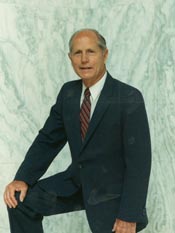Glenn M. Anderson
This article needs additional citations for verification. (March 2013) |
Glenn M. Anderson | |
|---|---|
 | |
| Member of the U.S. House of Representatives from California's 32nd district | |
| In office January 3, 1975 – January 3, 1993 | |
| Preceded by | Craig Hosmer |
| Succeeded by | Julian C. Dixon |
| Chairman of House Transportation Committee | |
| In office January 3, 1988 – January 3, 1991 | |
| Preceded by | James J. Howard |
| Succeeded by | Robert A. Roe |
| Member of the U.S. House of Representatives from California's 35th district | |
| In office January 3, 1973 – January 3, 1975 | |
| Preceded by | John G. Schmitz |
| Succeeded by | James F. Lloyd |
| Member of the U.S. House of Representatives from California's 17th district | |
| In office January 3, 1969 – January 3, 1973 | |
| Preceded by | Cecil R. King |
| Succeeded by | Pete McCloskey |
| 37th Lieutenant Governor of California | |
| In office January 5, 1959 – January 2, 1967 | |
| Governor | Pat Brown |
| Preceded by | Harold J. Powers |
| Succeeded by | Robert Finch |
| Member of the California State Assembly from the ? district | |
| In office 1943–1951 | |
| Mayor of Hawthorne | |
| In office 1940–1943 | |
| Personal details | |
| Born | February 21, 1913 Hawthorne, California, U.S. |
| Died | December 13, 1994 (aged 81) Los Angeles, California, U.S. |
| Resting place | Green Hills Memorial Park Rancho Palos Verdes, California, U.S. |
| Political party | Democratic |
| Alma mater | University of California, Los Angeles (B.A.) |
Glenn Malcolm Anderson (February 21, 1913 – December 13, 1994) was an American politician. He was the 37th Lieutenant Governor of California and later as congressman. He was a member of the Democratic Party.[1]
Anderson was born on February 21, 1913 in Hawthorne, California. He received a Bachelor of Arts from University of California, Los Angeles in 1936. He worked as a real estate developer and served in the United States Army.
Anderson was mayor of Hawthorne, California from 1940 to 1943 and a member of the California State Assembly from 1943 to 1951. He served as Lieutenant Governor of California from 1959 to 1967 but was defeated in a bid for a third term by Republican Robert Finch. During his office on August 13, 1965, he signed off on the orders to send 1,336 National Guard Troops into Los Angeles County, 48 hours after the Watts riots begun.
Anderson was first elected to the 91st Congress in 1968 and served 12 terms from 1969 to 1993. In Congress he became chair of the Committee on Public Works and Transportation. He decided not to run for re-election in 1992.
Anderson died on December 13, 1994[1] in Los Angeles, California, at the age of 81. He is interred in Green Hills Memorial Park, Rancho Palos Verdes, California.
The Interstate 105 in South Los Angeles is named in his honor as the "Glenn M. Anderson Freeway" but that name is rarely used. It is known colloquially as "the Century" or "the 105" freeway.
References
- ^ a b "Anderson, Glenn Malcolm". Who Was Who in America, 1993-1996, vol. 11. New Providence, N.J.: Marquis Who's Who. 1996. p. 6. ISBN 0837902258.
External links
- United States Congress. "Glenn M. Anderson (id: A000189)". Biographical Directory of the United States Congress.
- Glenn M. Anderson at Find a Grave
- 1913 births
- 1994 deaths
- California Democrats
- Lieutenant Governors of California
- Mayors of Hawthorne, California
- Members of the California State Assembly
- Members of the United States House of Representatives from California
- University of California, Los Angeles alumni
- Democratic Party members of the United States House of Representatives
- 20th-century American politicians

